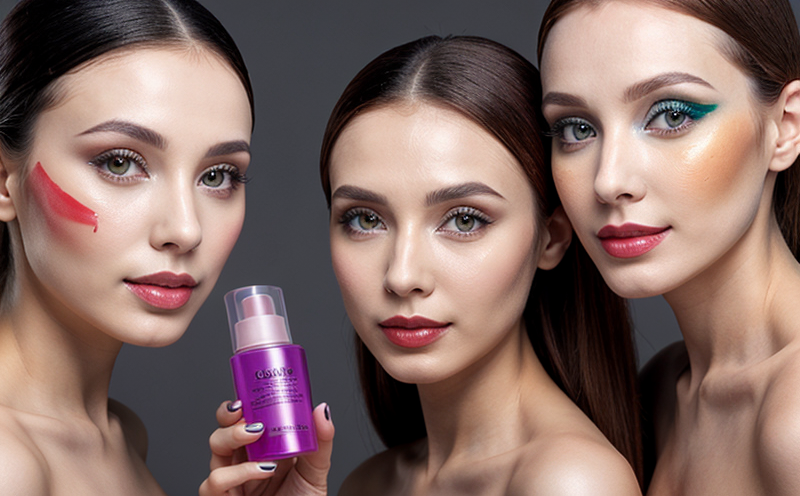In Vitro Skin Irritation Testing for Cosmetic Products
In vitro skin irritation testing is a crucial aspect of ensuring consumer safety and regulatory compliance in the cosmetics industry. This method involves simulating potential adverse effects on human skin without the use of animals, thereby aligning with ethical standards and promoting sustainable practices.
The primary goal of this test is to evaluate whether cosmetic products or their individual ingredients cause irritation when applied topically to human skin. The test typically uses reconstructed human epidermis (RHE) models that mimic the stratum corneum, allowing for accurate assessments of irritancy without the need for live animal testing.
The process begins with selecting an appropriate RHE model based on the cosmetic product’s intended use and formulation characteristics. Specimens are prepared by placing the RHE model in a controlled environment where it is exposed to the test substance under specified conditions, such as concentration levels and exposure duration. Following exposure, the integrity of the skin barrier is assessed using various endpoints, including transepidermal water loss (TEWL), fluorescence imaging, and histological analysis.
The results from these assessments are compared against predefined thresholds to determine whether the test substance causes irritation. This approach ensures that only safe products reach consumers, thus protecting public health while fostering innovation in the cosmetics sector.
Compliance with international standards such as ISO 10993-10 and OECD Guideline for Testing Chemicals No. 435 underscores the reliability of this method. These guidelines provide specific protocols for conducting in vitro skin irritation tests, ensuring consistency across laboratories worldwide.
The benefits of in vitro skin irritation testing extend beyond mere compliance; it also offers significant advantages in terms of efficiency and cost-effectiveness. By reducing the need for animal testing, companies can accelerate product development cycles and lower associated costs. Additionally, this non-animal approach enhances brand reputation by demonstrating a commitment to ethical practices.
Despite its numerous benefits, implementing effective in vitro skin irritation testing requires careful planning and execution. Laboratories must invest in high-quality RHE models, advanced instrumentation for precise measurement, and experienced personnel who can interpret results accurately. Regular calibration of equipment and adherence to strict quality control measures further ensure the accuracy and reliability of test outcomes.
In conclusion, in vitro skin irritation testing represents a vital component of modern cosmetic product development and regulatory compliance. Its ability to provide accurate, reproducible results while adhering to ethical standards makes it an indispensable tool for ensuring both consumer safety and sustainable business practices within the cosmetics industry.
Applied Standards
The in vitro skin irritation testing method is governed by several international standards designed to ensure consistency, reliability, and accuracy. The most widely recognized standards include:
| Standard Name | Description |
|---|---|
| ISO 10993-10:2018 | In vitro Corrosion Test for Metallic Implants and Biomaterials |
| OECD Guideline for Testing Chemicals No. 435 | In Vitro Skin Irritation Test Using Reconstructed Human Epidermis (RHE) |
These standards provide detailed protocols and requirements that laboratories must follow when conducting in vitro skin irritation tests. Compliance with these guidelines ensures that the results are valid, reliable, and acceptable to regulatory bodies around the world.
Industry Applications
| Application Area | Description |
|---|---|
| Cosmetics and Personal Care Products | Evaluation of new formulations for safety and efficacy. |
| Pharmaceutical Cosmetics | Assessment of drug delivery systems and topical medications. |
| Sun Care Products | Determination of SPF levels and sun protection effectiveness. |
| Makeup and Fragrances | Testing for potential allergens and irritants in fragrances. |
In vitro skin irritation testing plays a pivotal role across various segments of the cosmetics industry, from raw material suppliers to finished product manufacturers. By providing comprehensive data on ingredient safety, this method helps ensure that all cosmetic products meet stringent quality and regulatory standards.
Use Cases and Application Examples
In vitro skin irritation testing is employed in numerous scenarios to evaluate the safety of new cosmetic formulations. Here are some practical examples:
- New Product Launch: Before launching a new product, manufacturers conduct rigorous tests to ensure that it meets all regulatory requirements.
- Ingredient Evaluation: When introducing a novel ingredient into an existing formula, companies use this test to assess its potential for causing irritation or adverse reactions.
- Formulation Optimization: During the development process, in vitro tests help identify any problematic ingredients that need adjustment or removal.
- Quality Control: Regular testing during production ensures consistency and adherence to quality standards throughout the manufacturing cycle.
These use cases highlight how in vitro skin irritation testing is integral to the cosmetic industry, supporting innovation while ensuring consumer safety. By leveraging this method, companies can confidently introduce safe and effective products to market.





